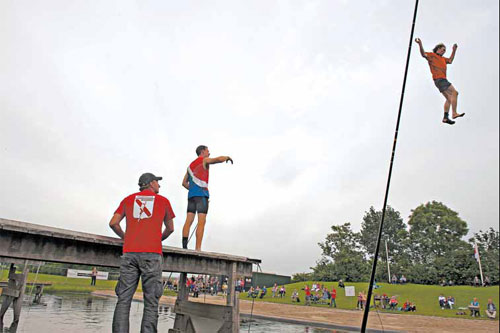
 |
|
Canal-vaulting evolved in a land where canals were ubiquitous, but bridges less so. A contest in Linschoten, the Netherlands, in June. Herman Wouters for The New York Times |
Linschoten, the Netherlands
Years ago, the story goes, Dutch farmers crossed the canals dividing their fields by vaulting over them with a pole, since bridges were few and far between. This apparently never translated into Olympic glory in the pole vault, but it did give rise to a sport - canal-vaulting.
It is one of several little-known Dutch sports enjoying a revival. Kolf and pole-sitting are others.
Canal-vaulters do not try to go high, like pole-vaulters, but long. They dig the point of their poles, a maximum of 17 meters, into the bed of the canal, take a running start, leap onto the pole and climb up it, then throw themselves to the other side.

When Erik Bos, 37, took his second of three tries in a contest in this village recently, he suffered a common fate of canal-vaulters, tumbling into the cold water of the 14-meter-wide canal. Jaco de Groot, 26, jumped 20 meters, the farthest of anyone that evening, but only after plunging twice into the canal.
Records of competitions go back to the mid-18th century. The sport thrived for a while after World War II, then waned again until recent years.
"People understand now that it's part of our culture," said Peter Hielema, 40. "Twenty years ago, there were very few competitions."
In the village of Wormer on a recent afternoon, another venerable Dutch sport, kolf, drew a dozen enthusiasts. Also called kolven, it is similar to French petanque and golf. A kolf club is used to hit balls at two posts at either end of a court nearly 18 meters long and 5 meters wide.
About 300 years ago, there were 217 kolf courts in Amsterdam alone. Today, there are just 14 in all of the Netherlands.
But the number may be on the rise. Mark Aberkrom, 48, a financial consultant, discovered kolf after he bought a former tavern and found the remains of a kolf court there. In the 19th century, he said, "what killed kolf was the French game of billiards." Five or six billiard tables could occupy the space of one kolf court.
The club now has 48 members. "We are an example for other clubs that you can grow," he said.
Neither canal-vaulting nor kolf has caught on outside the Netherlands, but for the past 18 years Aruba, the Caribbean island that remains part of the Netherlands, has been holding a local championship for paalzitten, or pole-sitting.
This sport arose from the habit of Dutch canal boat hands' resting on the poles that lined the canals to moor barges. This year's competition in Oranjestad, the capital of Aruba, involved four people who climbed onto poles to see who could sit the longest, toilet breaks every few hours being the only interruption allowed.
After 87 hours and 52 minutes, Liesbeth Cornes, 31, a cafe employee, climbed down victorious, sharing the honor with another islander, Shurman Milliard. After this victory, Ms. Cornes decided to retire. "This is the last year for me," she said by phone. "I don't have to prove myself."
The New York Times